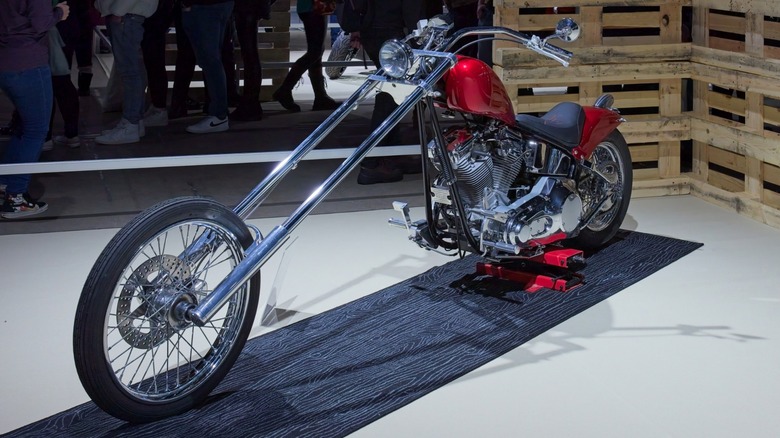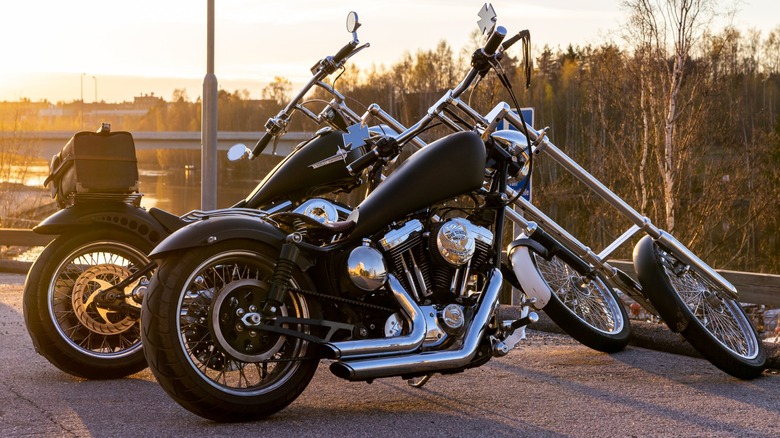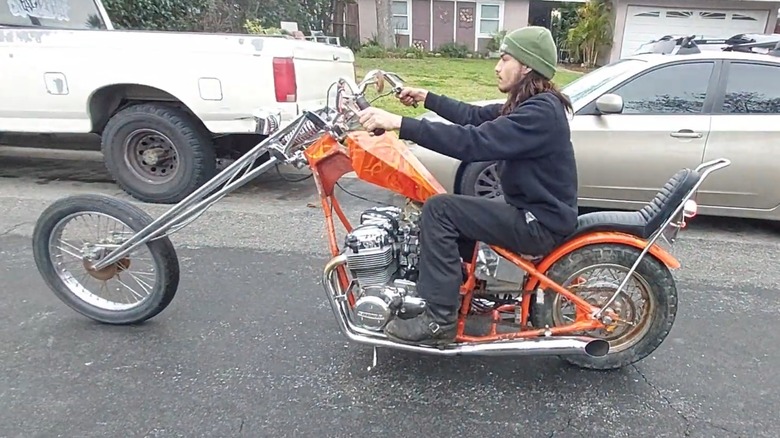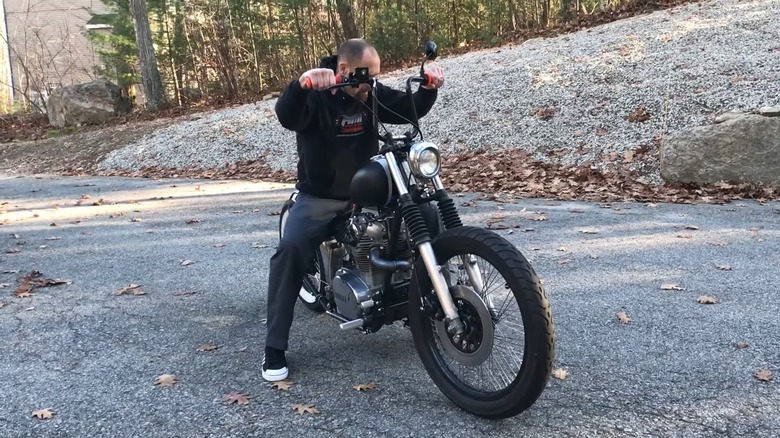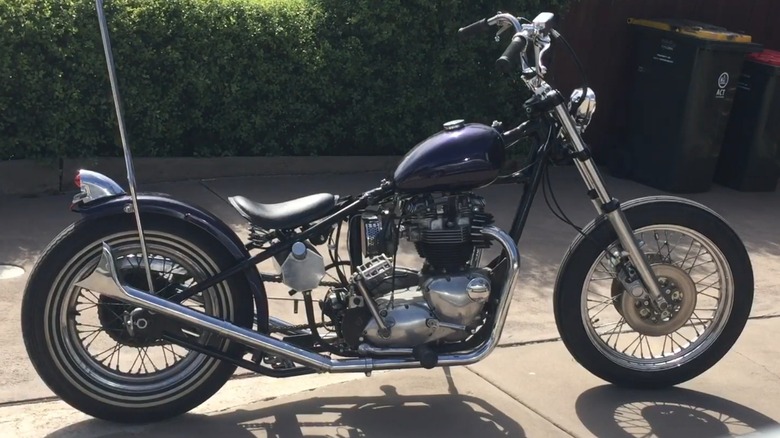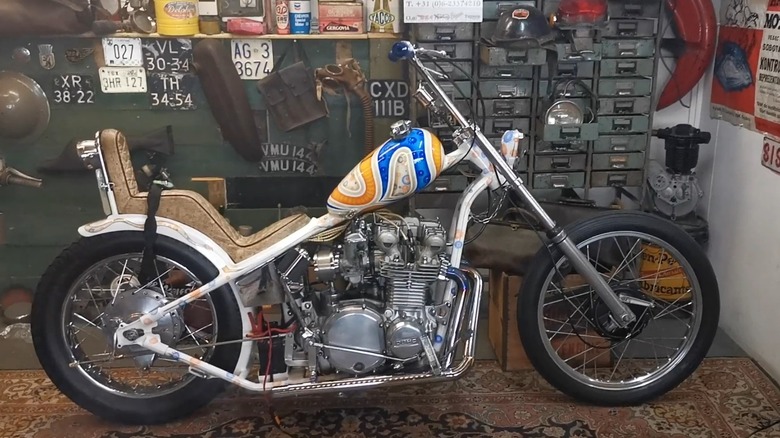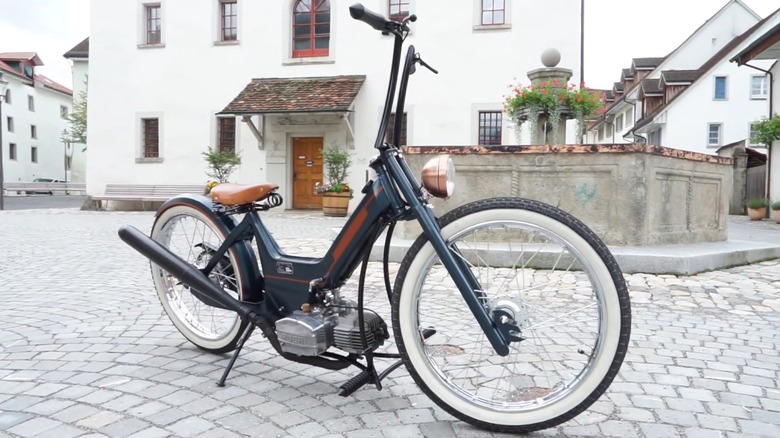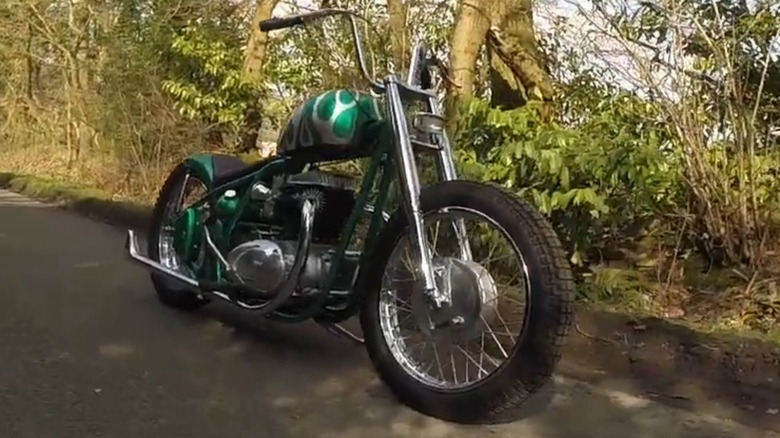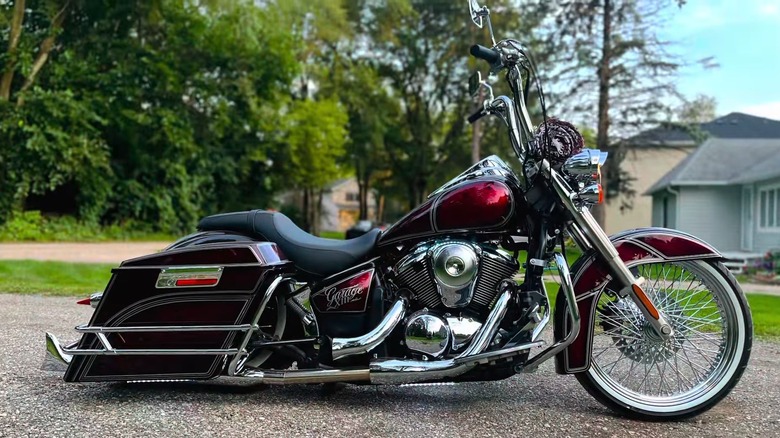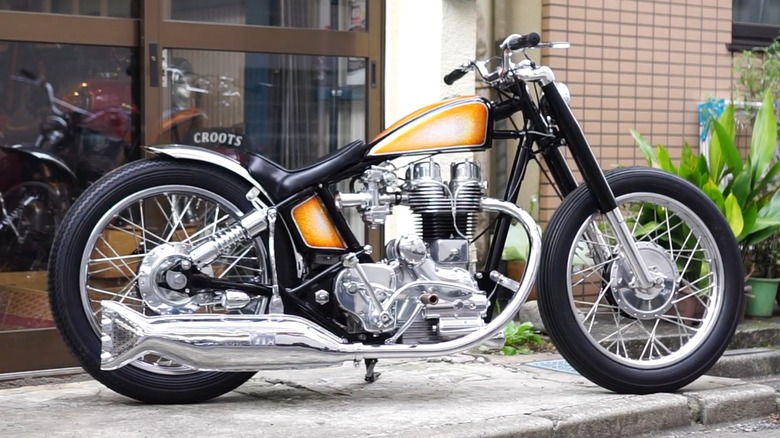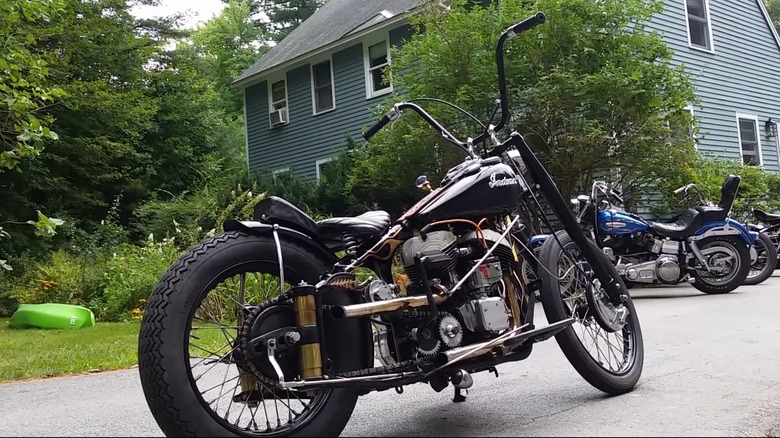10 Motorcycles To Consider For A Custom Chopper Build
Modifying motorcycles to make more speed by reducing weight is a tradition stretching back to before WWII. These "bob jobs" or "bobbers" strip anything not necessary, leaving a lighter and nimbler machine behind. After WWII, former G.I.s who became accustomed to riding the Harley-Davidson WLAs in Europe were able to pick them up dirt cheap and started customizing them much in the bobber tradition but taking things to an extreme. The trend of highly customized bikes evolved into a style coming out of California involving ludicrously long forks, extra tall sissy bars, and intricate custom paint, and the bikes are called choppers.
Choppers generally have the least possible equipment remaining on the motorcycle and go so far as to have few of the original parts. The frames are extensively modified and often carry engines with significant performance modifications, although many are unmodified. It can be hard to define choppers as so much personalization goes into building one.
Creating a chopper requires significant skill. I am a long-time rider as well as a professional mechanic with a lot of motorcycle experience. However, I have never attempted to build a chopper as I know how much work goes into them, and I am most impressed with the skills of those who do. Daunting as it may be, you must start with something, and some bikes are just better suited than others. Therefore, these motorcycles might make a perfect chopper for your next custom build.
Harley-Davidson Sportster
As one of the longest running models of motorcycle from any continent, Harley-Davidson's Sportsters populate the roads all over the world as uniquely American icons of the street. Upon its introduction in 1957, longevity was not guaranteed, particularly as loyal riders scoffed at the new smaller v-twin machines from Milwaukee. And while riders preferring a lighter ride contribute to the success, the smaller size makes it perfect to emulate something like Captain America, one of the most famous movie motorcycles, appearing in the film "Easy Rider."
Given that chopper builders are partial to stripped-down versions of a bike with few superfluous accessories in the pursuit of reducing weight, a small frame with a lighter engine makes a good place to start. Many choppers are based on hardtail frames, meaning they lack a rear suspension. This allows them to have a truly bare frame look toward the back, although it makes for a bumpier ride. But since Harley-Davidson introduced its first models with rear suspension in 1958, complete and original hardtails become harder to find everyday.
Instead of searching for a rare and possibly vintage hardtail, Sportsters are easily converted with kits available for models from 1982 to 2003. Once converted, the rest of the work can be as easy or hard as you want it, depending on how extreme you want your chopper. Few other models turn into a chopper as readily as a Sportster, and with plentiful used models around, getting started is cheap.
Honda CB750
While it might seem that a v-twin bike is the natural base for a chopper build, a surprising number of builders choose Honda and its venerable breakout success CB750 superbike. As Honda's first go at competing in the American market with a big and fast 4-cylinder motorcycle, the CB750 made a considerable impression that led to robust sales — Honda sold 3,000 units per month. Being so popular and the sales generated by this model inevitably led to an abundance of frames and engines available in the following years, which makes them perfect for customization.
To be clear, transforming a classic Universal Japanese Motorcycle such as the CB750 into a chopper requires extensive modifications. Taking a bike with a mostly upright posture that is spring for a firm but comfortable ride and grafting the rear wheel directly to the frame takes work. That said, a wide variety of parts and kits for performing this task remain widely available today. But with the right blend of parts amassed and executed on a build, the results can be impressive, making you forget it was ever a Japanese bike at all.
Like any particular model and style of motorcycle, the CB750 "Hondachopper" has its own subculture of dedicated builders. These builds became popular in the '70s as the Harleys being used to build choppers back then became scarce, and parts availability waned. The abundance of frames and spare parts made Hondas excellent stand-ins, and the legendary reliability came as a bonus.
Yamaha XS650
British parallel twins ruled the 1960s as the imported motorcycle of choice, finding success thanks to the compact packaging and high power output. However, changes across the industry at the time led to the eventual demise of most British bikes — but not the parallel twin. Yamaha's first 4-stroke entry into the street bike category picked up the torch and ran with it into the 1980s.
The 1969 XS-1, which was later badged XS650, helped to fill the emerging void of European bikes with a well-built and affordably priced 650 twin. It was actually rooted in European production as the engine design came from German motorcycle maker Horex. Using Euro engineering combined with Japanese quality control, the Yamaha twin went on to become a popular model with excellent sales. With an influx of XS bikes on the market, custom shops began making choppers out of them, establishing another subculture with a dedicated custom parts supply.
The XS650 makes a great chopper because it's a relatively uncomplicated bike to begin with, and the twin-cylinder engine remains compact, unlike an ultra-wide inline-4. With the requisite hardtail welded to the existing Yamaha frame, few modifications are required, and the bolt-on forks, seat, rear fender, and pegs can complete the project, although more can be done if desired. One of the biggest benefits of this custom job is that the Yamaha XS650 is one of Yamaha's most reliable bikes ever made, allowing you to ride on past v-twins stuck on the shoulder.
Triumph Thunderbird
One of the world's great makers of motorcycles is Triumph, a U.K. manufacturer born in the Victorian Era. The company began making bicycles before transitioning to motorized cycles and has had a tumultuous history, including nearly going bankrupt in the 1980s. But before it had to compete with the Japanese during the days of Reagan and Thatcher, it held a prominent position in the market as one of the leading imported makers in the U.S.
While British parallel twins gained enormous popularity in the post-war period, Triumph started the trend with its 1937 Speed Twin. After the war, soldiers who had experience with Triumphs began snatching them up from dealers until they enjoyed wide appeal, finding prominent placement in movies such as "The Wild One" with Marlon Brando in 1953 and "The Great Escape" with Steve McQueen in 1962, featuring a Triumph TR6R. The multitude of Triumphs made way for chopper customs.
Early Thunderbirds used hardtail frames, providing an easy base to build a chopper. Furthermore, the slim parallel-twin engine keeps the bike narrow and light, although it may not make as much power as other options. Parts are readily available and the aftermarket offers a wide range of custom options, including hardtail kits for later models, with bolt-on versions for easy modification. No matter what Triumph you start with, the end will have the classic "bad boy" look that made these bikes cool in the first place.
Kawasaki KZ650/750/900/1000
Back in 1973, the Kawasaki Z1 debuted as the fastest production motorcycle made to that point. It was a stunner that set off a horsepower race among Japanese motorcycle manufacturers and raked up multiple wins for Kawasaki. The 4-cylinder DOHC engine was praised for its generous power delivery and incredibly smooth operation, and proved to be such a good design it remained in production for over a decade. Kawasaki used it in the follow-up model dubbed the KZ900, of which many variants were made.
The KZ models sold well, and the 1976 KZ900 LTD introduced a bit of American cruiser style not seen before on Japanese bikes. Production ended for all models in 1985, leaving a dozen years of bikes available for inline chopper building for anyone who wants a chopper that is both stylish and fast.
Even though production ended years ago, these bikes are plentiful, often in poor condition and at a low price — perfect for chopper building. However, they are getting harder to find every day. You might not see as many Kawasaki KZ choppers as some other models. Furthermore, inline engines are typically not as popular as v-twins, although a few parallel twins exist, such as the KZ400 and the KZ750 twin. That said, kits are available for conversions. So if you are willing to put in the work, a KZ1000 chopper that is faster than it deserves to be could be in your future.
Puch Maxi
It's tough to imagine why any hardcore biker who's a fan of the classic chopper would want to prepare anything about a moped. But when you see what kinds of interesting custom jobs people are doing with some mopeds, you might be at least marginally impressed. And for clarity, a moped — a portmanteau of motor and pedal — is like a motorized bicycle and has working pedals. It is not a scooter, like a Vespa.
Puch, an Austrian manufacturer, was one of the largest manufacturers of mopeds, and a surprising number of riders continue to restore and modify these diminutive bikes. Powered by 49cc engines with a tube frame, vintage Puchs are easy to modify on the cheap. However, production ended in 1987, so they can be hard to find. Regardless, there are many parts available to add performance to the engine including 70cc cylinder kits, performance exhaust pipes, and larger carburetors. But the frame and suspension will require custom fabrication work. For some bikes, installing extended forks alone gives it the chopper look while the more polished customs alter the neck to properly rake the forks.
A moped chopper does not necessarily have to be a Puch. Moped Army, a surprisingly active community of moped riders, lists about 75 brands of moped. Furthermore, a chopper photos thread on the site displays photos of dozens of custom chopper mopeds of the most fascinating and inventive builds imaginable, and all of them just look like fun.
BSA Thunderbolt 650
The Birmingham Small Arms company was founded in 1861 to produce rifles, gaining military contracts to sustain its operations at scale. It later diversified into bicycle manufacturing and then into motorcycles after engine technology spread. The motorcycle part of the business continued to grow until it was one of the largest makers of two-wheelers in the world, maintaining a 25% share of worldwide production.
Although BSA dominated in the post-war years, by 1973, production ceased. With such a good run, BSA bikes were everywhere, including a scene in the James Bond film "Thunderball." Like other British bikes of the era, BSA used a robust parallel twin to power its bikes. These compact engines make for slender choppers with the possibility of twin custom exhaust pipes, which can be elaborately styled design accents.
Chopper conversions for BSA can take a few routes, including an original hardtail, hardtail conversion, or one with its original suspension. The Thunderbolt is nice, but truthfully, any model will do. The fully suspended BSA choppers look every bit as good as the hardtail version while providing more comfort. Hardtail conversions that work with Triumph or BSA are available – BSA bought Triumph in the 1950s. The real question when working with a vintage BSA is whether it is one worthy of an original restoration or something suitably rough to justify hacking up an irreplaceable bike to turn into something else.
Kawasaki Vulcan
In 1976, Kawasaki released what is considered the first Japanese factory custom, which today would be called a cruiser. While it was not an instantaneous hit, it warmed buyers to a different style coming from an Asian manufacturer. That took off and the trend spread to other makers. This evolved into Japanese production of proper v-twin cruisers that more closely mimicked the American cruiser style, and Kawasaki's entry came in 1984 with its Vulcan 750.
The first Vulcan came with a similar style to the Harleys of the day, but its water-cooled v-twin with overhead cams was miles away in sophistication and quality. All Vulcans are water-cooled, but after a couple of years, Kawasaki added cooling fins to give the look of an air-cooled engine. Furthermore, Kawasaki once offered a Vulcan with a massive 2.0-liter v-twin laden with torque, the largest of its kind.
A Vulcan can be made into a chopper, but it will be far different from the conversions done to older Yamahas, Triumphs, or Harleys. Since many Vulcans are made with a hidden rear suspension to create a hardtail look, no major frame modifications are needed. Kits are available for installation of extra long forks with varying rakes that are bolt-on accessories. Once installed, the only work needed is all about looks. The Vulcan is a good choice for anyone who wants a chopper without going vintage. A Vulcan chopper will be reliable, comfortable, and require little maintenance. It is the best of both worlds.
Royal Enfield
Part of the origin of the chopper stems from WWII veterans picking up surplus military WLA Harleys and chopping off the unnecessary gear to save weight while spending very little. In modern times, choppers can be elaborate works of art with so much custom work done that nearly none of the original bikes exist. These can also cost thousands if not tens of thousands of dollars. But in the spirit of the originals, perhaps no bike is better suited than a Royal Enfield.
Built in India, Royal Enfield bikes are among the cheapest new motorcycles on the market. New Enfields make a great choice for a budget chopper, and quality of late-model bikes has markedly improved over the last five years, giving builders some peace of mind.
Enfield produces smaller bikes traditional to its home market. Its wide range of 350cc to 650cc models make perfect choices for an entry-level chopper while its parallel twins are classic British designs popular for use as choppers. Because Enfield has a small presence in America, choices for custom parts and chopper kits will be slim. But if you have a design idea and are handy with a welder and torch, there are no limits. Furthermore, many Indian custom shops build choppers and bobbers that can serve as inspiration. Furthermore, Enfield's list of endorsed custom shops in India create Enfield choppers as impressive as anything from L.A.
Indian Chief
No discussion of custom American v-twin motorcycles can be complete without mentioning Indian. With its beginnings in 1901, Indian helped establish American motorcycle manufacturing, contributing to the dominance of the v-twin engine in the region, and some of these early Indian motorcycles are now worth a small fortune. The company suffered many ups and downs, changing hands several times before ending production completely, only to be revived twice in the modern era.
Throughout Indian's time in and out of production, the Chief moniker has been applied to a production bike several times. The Chief today is a very expensive bike as it was back in the '20s, when they sold for about $300 — the same as a Model T. Nonetheless, they are all beautiful machines that share many design elements while retaining unique qualities.
Chiefs have long been targets of chopper builders. Classic Indians are quite valuable today, so you should only want to modify a real basket case. If you can find one, the chopper build is easy as they are either original hard-tails or have the plunger rear suspension that maintains the same frame curve. With a sissy bar, only a minimalist rear fender, and some ape hangers, your Indian chopper will be complete. However, finding and purchasing a vintage Indian will still be the hardest part and the most expensive.
